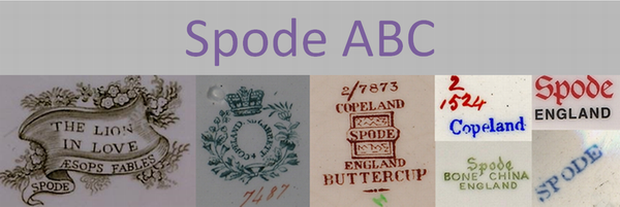Patterns with a D prefix are recorded in a set of pattern books known as the D Books. There are 9999 patterns in this series. The patterns are for all types of ware - tableware, tea and coffee wares, dessert wares, tiles, ornamental and toilet wares; and in all sorts of bodies such as earthenware, bone china, parian, stoneware and stone china.
This is the last main series before the patterns begin to be recorded in categories - each category then having its own prefix; for bone china, earthenware, toiletware, tiles etc. The aim is for each pattern number to be unique.
The D books date roughly from about 1850-1875.
D patterns of this series should not be confused with a later series of numbers with a D prefix created for specially commissioned designs which was begun in 1980.
Confusingly, in the late 19th century D was also used as a prefix for some shape numbers in catalogues, particularly for items made in parian ware.
Dessert Pyramids
See Pyramids
Dickens, Charles
Click Spode and Charles Dickens to find out more about this celebrity author who visited the Spode factory in 1852. He wrote an excellent article about his tour around the Spode factory describing all the manufacturing details at that time. And, of course ordered his personalised dinner service from Spode too.
Dresden Rose
See Savoy on the S page
Duke of Wellington
There are several connections between Spode and the Duke of Wellington. Click HERE> for my blog 'Spode, Copeland, Waterloo and the Duke of Wellington'.
 |
| Backstamp on a bust of Wellington c1824 |
Engine Turned wares
For a definition of engine turned wares, and a short film, go to the E page on Potbank Dictionary.
 |
Beaker match pot, engine turned, red slip over creamware,
green glazed c1800
|
English Lavender
 |
| Leaflet 1959 |
During and after World War II (1939-1945) no decorated pottery was allowed to be sold in the UK except seconds and export rejects. The restrictions lasted from 1942-1952.
The main tableware was 'Utility' and in the case of Spode was made to exactly the same high standard as was expected from a leading manufacturer. With the slight relaxation in restrictions after the war coloured bodies were introduced. English Lavender was one of these. It was inspired by lavender colour used in decoration and bodies from the early 1800s.
 |
| Hamilton pattern plate |
 |
| Hamilton pattern cream/milk jug (detail) |


